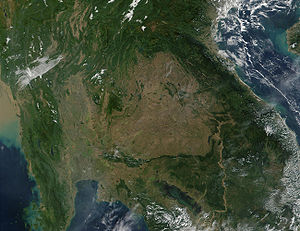
Deforestation in Thailand
Encyclopedia

Thailand
Thailand , officially the Kingdom of Thailand , formerly known as Siam , is a country located at the centre of the Indochina peninsula and Southeast Asia. It is bordered to the north by Burma and Laos, to the east by Laos and Cambodia, to the south by the Gulf of Thailand and Malaysia, and to the...
declined from 61% to 34% of the country’s land area. Over the next 11 years, Thailand lost close to 28% of all of its remaining forests. This means that the country lost 3.1% of its forest cover each year over that period. Northern Thailand, the most heavily forested region of the country, was not subject to central government and settlement until the second half of the nineteenth century when British timber firms, notably the Bombay Burma Trading Corporation Ltd and the Borneo Company Ltd, entered into the teak trade in the late 1880s and early 1890. The Royal Forest Department, created in 1896 and staffed by a British forester until 1925, sought to conserve the forests against the worst business practices of British, Thai, and Chinese timber firms who worked in the region.
During the twentieth century, deforestation in Thailand was driven primarily by agricultural expansion, although teak deforestation happened as a direct result of timber-cutting. Much of Thailand’s recent economic improvement can be attributed to increased agricultural production for export. The country was able to increase production by clearing much of their forests and converting them to cropland.
History of Thai forest management
- In 1896 the Ministry of the Interior established the Royal Forest Department to conserve forests and control revenue from the teak forests in northern Thailand. A British forester from Burma, Herbert Slade, served as the first director of the Department. From 1896-1925 the Thai government and British foresters and businesses created an 'informal empire' over the teak forests of northern Thailand.
- In 1899 all forests were declared government property and all logging without payment to the Royal Forest Department was prohibited.
- In 1956 The Forest Industry Organization was established to take over government control of industrial uses of Thai forests.
- In 1962 the Thai government began to establish national parks and other forest conservation areas, their management was still under the jurisdiction of the Royal Forest Department. In the sixties there was a large shift in the forest use in Thailand. Deforestation began to increase but not due to the commercial uses in the teak forests in the north but rather the increased export agriculture being done in the south.
- In the late 1960’s the Thai government began to grant logging concessions, which required re-planting but were poorly managed.
- A military coup in 1976 led to political instability. The military began to clear forests to suppress rebel forces that had settled in the forests for protection.
- The political instability left the government with little power to protect forests and illegal logging was pursued more heavily by villagers. During the height of illegal logging in Thailand it is estimated that somewhere between 50-75% of timber coming out of Thailand was obtained illegally.
- In the 1980s the government took many steps to limit the speed at which Thailand’s forests were disappearing. They set a target for 40% forest cover. To achieve this they initiated tree planting initiatives and leased some degraded forests to third parties to create logging plantations.
- In 1988 a flood in southern Thailand finally set in motion a complete ban on all commercial logging that was put in place in 1989.

